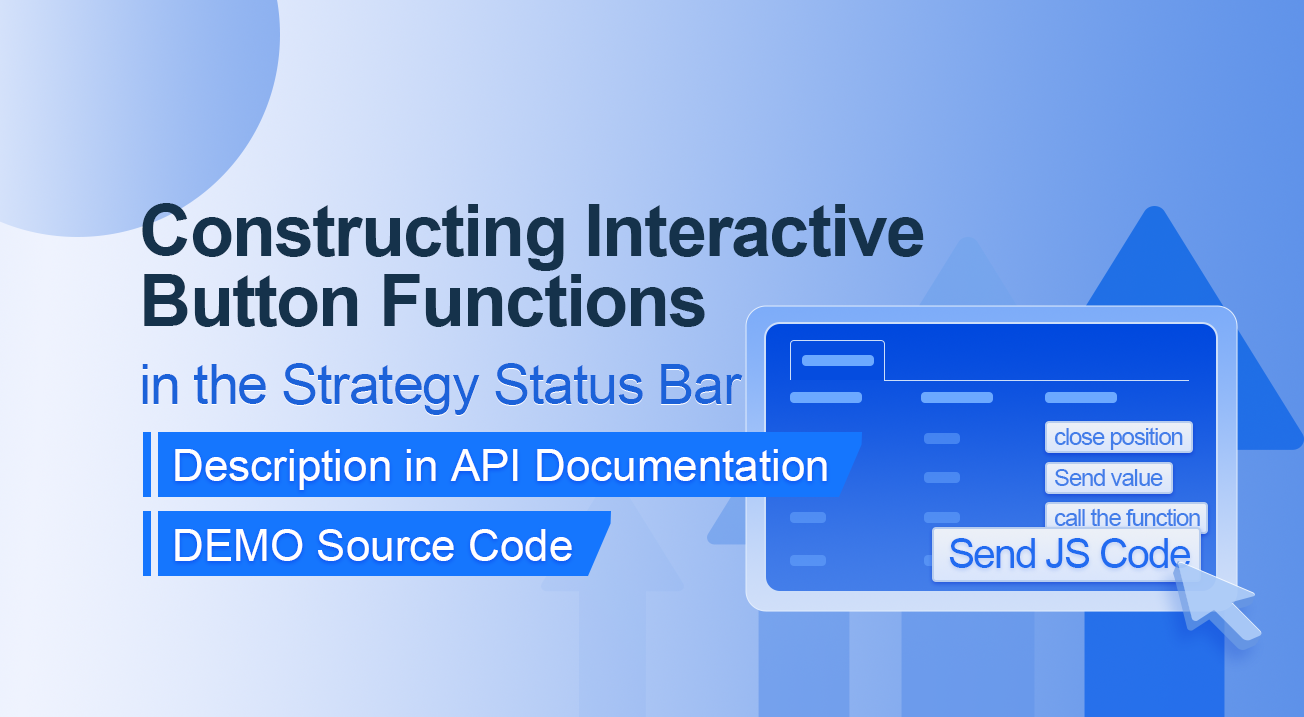Erstellen von interaktiven Tastenfunktionen in der Strategie-Statusleiste
Schriftsteller:Lydia., Erstellt: 2023-07-13 14:14:38, aktualisiert: 2024-01-02 21:29:26
Erstellen von interaktiven Tastenfunktionen in der Strategie-Statusleiste
Beschreibung in der API-Dokumentation
// You can also construct a button in the form, and use GetCommand to receive the contents of the cmd attribute.
var table = {
type: 'table',
title: 'position operation',
cols: ['Column1', 'Column2', 'Action'],
rows: [
['abc', 'def', {'type':'button', 'cmd': 'coverAll', 'name': 'close position'}],
]
};
LogStatus('`' + JSON.stringify(table) + '`')
// Or construct a separate button
LogStatus('`' + JSON.stringify({'type':'button', 'cmd': 'coverAll', 'name': 'close position'}) + '`')
// Button styles can be customized (bootstrap's button attributes)
LogStatus('`' + JSON.stringify({'type':'button', 'class': 'btn btn-xs btn-danger', 'cmd': 'coverAll', 'name': 'close position'}) + '`')
Die API-Dokumentation zeigt, dass die Anzeige von Tabellen, Zeichenfolgen, Bildern, Diagrammen usw. in der Strategie-Statusleiste durch Aufrufen der API-Funktion erreicht wird:
LogStatus- Ich weiß. Wir können auch eine interaktive Schaltfläche einrichten, indem wir eine JSON-Daten erstellen.
DEMO-Quellcode:
function test1(p) {
Log("Calls a custom function with parameters:", p);
return p;
}
function main() {
while (true) {
var table = {
type: 'table',
title: 'position operation',
cols: ['Column1', 'Column2', 'Action'],
rows: [
['a', '1', {
'type': 'button', // To display a button, you must set the type to button.
'cmd': "CoverAll", // String, sent data, accepted by the GetCommand() function.
'name': 'close position' // The name displayed on the button.
}],
['b', '1', {
'type': 'button',
'cmd': 10, // numerical value
'name': 'Send value'
}],
['c', '1', {
'type': 'button',
'cmd': _D(), // The function is called for the duration of the strategy run
'name': 'call the function'
}],
['d', '1', {
'type': 'button',
'cmd': 'JScode:test1("ceshi")', // String, the JS code to execute.
'name': 'Send JS Code'
}]
]
};
LogStatus('`' + JSON.stringify(table) + '`')
var str_cmd = GetCommand();
if (str_cmd) {
Log("Received Interaction Data str_cmd:", "type:", typeof(str_cmd), "value:", str_cmd);
}
if (str_cmd && str_cmd.split(':', 2)[0] == "JScode") { // Determine if there is a message
var js = str_cmd.split(':', 2)[1]; // Split the returned message string, limit it to two, and assign the element with index 1 to a variable named js.
Log("Execute debugging code:", js); // Output executed code
try { // Abnormal detection
eval(js); // Executes the eval function, which executes the parameters (code) passed in.
} catch (e) { // throw an exception
Log("Exception", e); // Output error messages
}
}
Sleep(500);
}
}
Die Strategie läuft wie gezeigt:

Wir können die Interaktion auslösen, indem wir auf die Tasten in der Tabelle auf der Statusleiste klicken.
Wenn wir auf die Schaltfläche


> But it doesn't work when you click on "Send value" because[ ```'cmd': 10, // value``` ]Here is 10. Numeric types cannot be sent.
https://www.fmz.com
# It has been optimized to be compatible with numeric values, and returns a string of values.
Als nächstes klicken wir auf die Schaltfläche
Die eingegangenen Daten werden in das Protokoll gedruckt:


Schließlich klicken wir auf die Schaltfläche
function test1(p) {
Log("Calls a custom function with parameters:", p);
return p;
}
Klicken Sie auf:


Sie können sehen, dass die Log (("Anrufen einer benutzerdefinierten Funktion mit Parametern: ", p); Anweisung in der Funktion test1 ausgeführt wurde.
Durch das Einfügen von

Fangen Sie an und üben Sie sofort!
- FMZ Quantitative Uniswap V3 Betriebsanleitungen für die Wechselpool-Liquidität (I)
- Strategie-Schnittstellenparameter-Einstellungen
- FMZ Kryptowährung Quantitative Plattform WebSocket Benutzerhandbuch (ausführliche Erläuterung der aktualisierten Wählfunktion)
- Kurzkurs in Python in X Minuten
- Kurzkurs in JavaScript in X Minuten
- In Bezug auf die Platzierung von BitMEX Post-Only-Limit-Orders und Batch-Orders unter Verwendung von IO (ein Beispiel)
- Open-Source FMZ Quant TA-Bibliothek, lernen Sie zu verwenden (mit Javascript/Python/C++ Versionen)
- FMZ Quant Trading Platform benutzerdefiniertes Protokoll Zugriff auf benutzerdefinierte Börsen
- FMZ hat die lokale Python-Backtest-Engine gestartet.
- Fortgeschrittene Tutorials zum Schreiben von FMZ Quant-Plattformstrategien
- Anwendung der Funktion "__Thread" im JavaScript-Strategiedesign